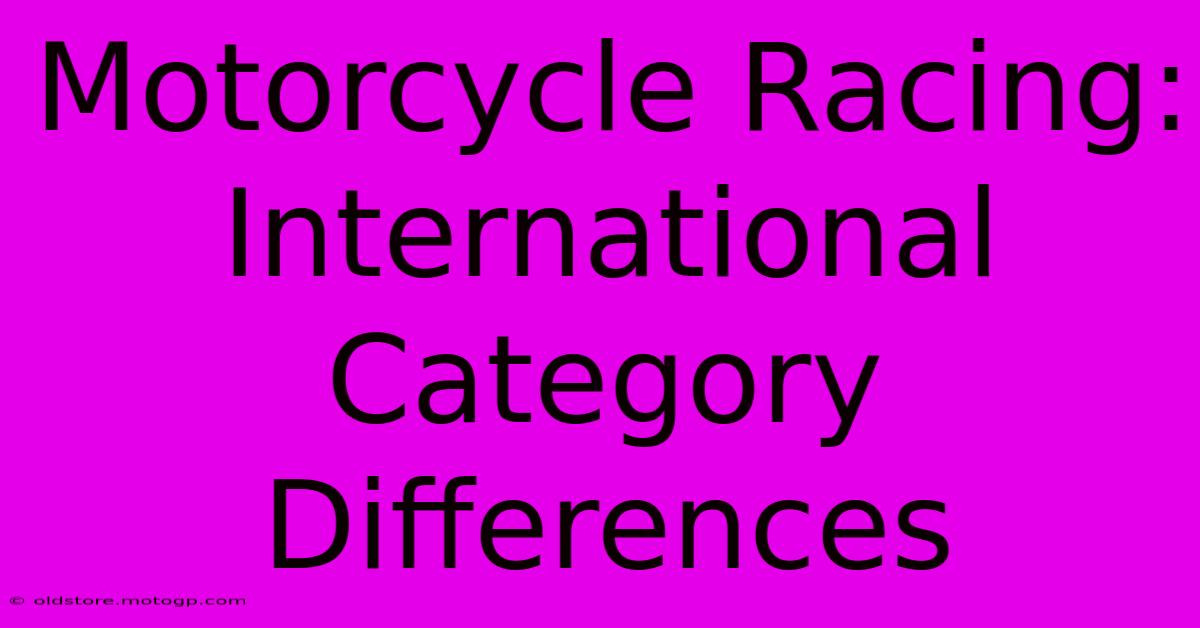Motorcycle Racing: International Category Differences

Table of Contents
Motorcycle Racing: International Category Differences
Motorcycle racing boasts a thrilling global landscape, with diverse categories captivating audiences worldwide. Understanding the differences between these international racing classes is key to appreciating the nuances of skill, technology, and competition. This article delves into the key distinctions, highlighting the unique challenges and rewards within each category.
MotoGP: The Pinnacle of Motorcycle Racing
MotoGP represents the pinnacle of motorcycle road racing. It's the premier class, featuring the most powerful and technologically advanced machines. These prototypes, boasting upwards of 260 horsepower, push the boundaries of engineering and rider skill.
Key Characteristics of MotoGP:
- Prototype Machines: These bikes are not mass-produced; they are purpose-built racing machines, constantly evolving with cutting-edge technology.
- Top Riders: The world's best riders compete here, vying for the coveted championship title.
- High Speeds and Intense Competition: Expect breathtaking speeds and incredibly close racing, with riders pushing their machines and themselves to the absolute limit.
- High Stakes: Massive sponsorship and significant prize money are at stake, attracting top teams and riders from around the globe.
Moto2: The Stepping Stone to MotoGP
Moto2 serves as a crucial stepping stone for aspiring MotoGP riders. While not as powerful as MotoGP machines, Moto2 bikes still demand exceptional skill and precision. The standardized Triumph 765cc engine ensures a level playing field, focusing competition on rider talent and team strategy.
Key Characteristics of Moto2:
- Standardized Engine: This promotes fairer competition, placing emphasis on rider ability and chassis setup.
- Development Focus: Teams concentrate on chassis development, electronics, and rider setup, rather than engine development.
- Competitive Field: A highly competitive environment provides excellent training for future MotoGP riders.
- Cost-Effective: Compared to MotoGP, Moto2 offers a more cost-effective entry point for teams and sponsors.
Moto3: The Entry Level to Grand Prix Racing
Moto3 is the entry-level class of Grand Prix racing, featuring smaller, lighter bikes with 250cc four-stroke engines. This category serves as a proving ground for young talent, fostering intense competition and skill development.
Key Characteristics of Moto3:
- Smaller, Lighter Bikes: These bikes are more manageable, making them ideal for younger, less experienced riders.
- Focus on Skill: The relatively smaller engine displacement emphasizes rider skill and precision.
- Youthful Talent: This category showcases some of the most exciting young riders on the circuit.
- Competitive Stepping Stone: Success in Moto3 can be a springboard to greater achievements in Moto2 and MotoGP.
World Superbike Championship (WSBK): Production-Based Racing
Unlike MotoGP's prototype machines, the World Superbike Championship (WSBK) uses modified production-based motorcycles. This means the bikes are derived from models available to the public, albeit heavily modified for racing.
Key Characteristics of WSBK:
- Production-Based Machines: This creates a stronger connection between the racing and the consumer market.
- Technological Advancements: While based on production models, these bikes still feature significant technological advancements for improved performance.
- Different Manufacturers: A wide range of manufacturers participate, showcasing their production-based racing prowess.
- Accessibility and Fan Engagement: The use of production-based bikes often leads to increased fan engagement and accessibility.
Beyond the Main Categories: Other Notable Series
Beyond these major classes, a vibrant world of other motorcycle racing categories exists, including:
- Supersport: Featuring 600cc production-based machines.
- British Superbike Championship (BSB): A highly competitive national championship in the UK.
- AMA Superbike: The premier American road racing championship.
- MotoAmerica: A popular series in the United States with various classes.
Each category presents unique challenges and showcases different aspects of motorcycle racing. From the cutting-edge technology of MotoGP to the accessible production-based machines of WSBK, the world of motorcycle racing provides a captivating spectacle for fans of all levels. Understanding these distinctions enhances the appreciation for the skill, dedication, and technology involved in this exhilarating sport.

Thank you for visiting our website wich cover about Motorcycle Racing: International Category Differences. We hope the information provided has been useful to you. Feel free to contact us if you have any questions or need further assistance. See you next time and dont miss to bookmark.
Featured Posts
-
Cota Travel Plan Ahead Arrive Relaxed
Feb 23, 2025
-
Circuit Of The Americas Deciphering The Lot F Mystery
Feb 23, 2025
-
Who Will Reign Supreme Malaysian Motorcycle Grand Prix
Feb 23, 2025
-
F1 Ratings A Comprehensive Analysis Of Driver Performance
Feb 23, 2025
-
Cota Parking Made Simple
Feb 23, 2025
